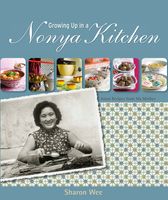Advertisement
Mortar and Pestle vs. Electric Blender
By Sharon Wee
Published 2012
Olden-day Nonyas could not live without their mortar and pestle. Mothers-in-law often judged the cooking proficiency of prospective brides by the pounding rhythm and fineness of their spice paste. The Nonyas called the mortar and pestle the batu lesong. Pounding was called tumbok-tumbok (pronounced toom-boke). With a new mortar, my mother pounded dry grated coconut to absorb the grit tucked into the micro fine crevices of the new mortar. You should pound the coconut until it leaves a shine to the surface of the mortar and pestle and it replaces the smell of granite. The mortar would eventually achieve a smooth surface after pounding many times over. This is essential so that bits of a spice paste would not get stuck in the tiny cracks and crevices. These days, new mortars come with smoothened surfaces. Some of these new ones are also made from a more inferior granite and therefore not held with the same regard by older cooks. A Nonya superstition is that you should stop using your batu lesong if the mortar base is wearing thin. You must not crack it, otherwise it would be bad luck. Whether it is to avoid the risk of wasting paste that required a chunk of time to pound or truly, to avoid ill fortune, another superstition admonishes you not to cross or walk over a batu lesong. The Nonyas would scream “jangan langga!” (don’t knock it over).


